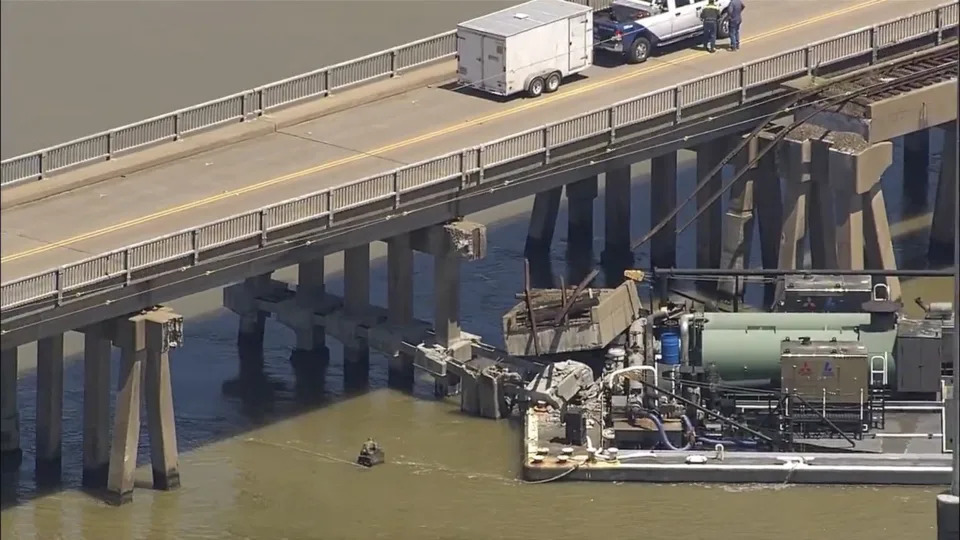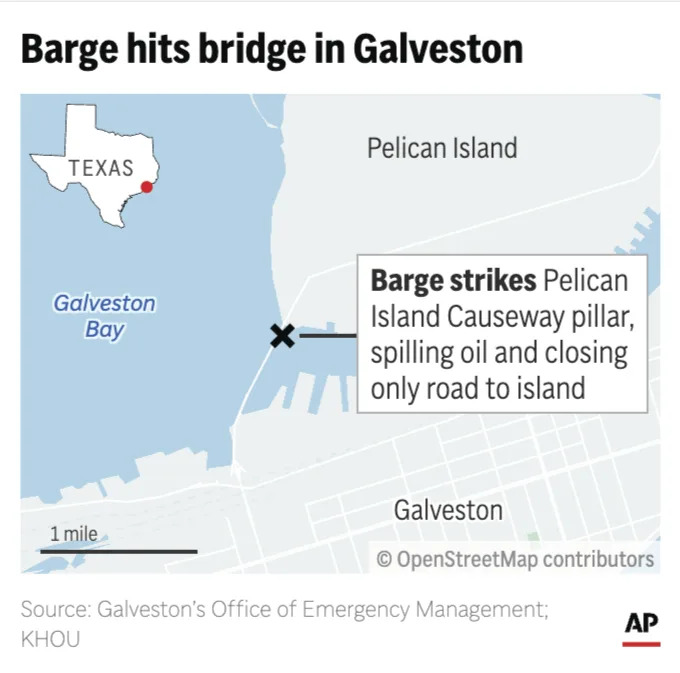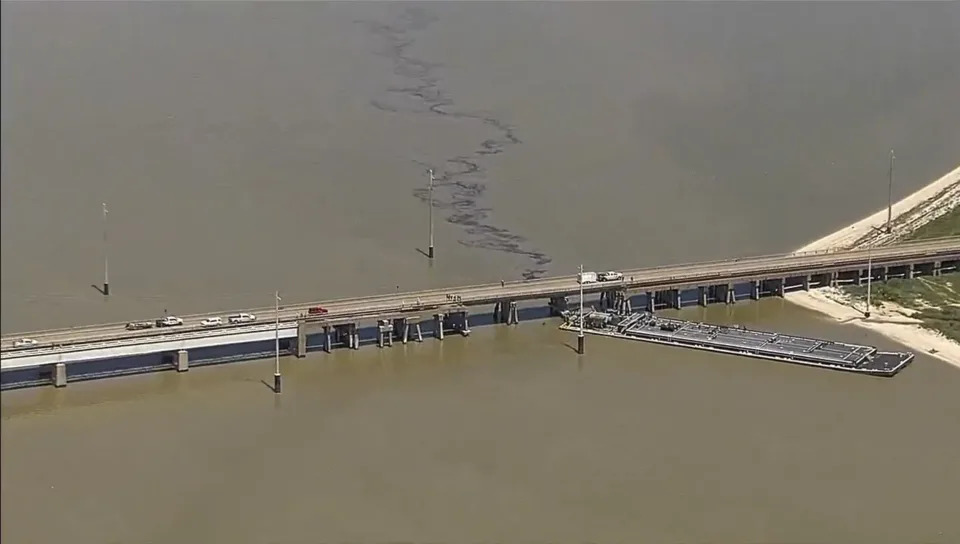LEKAN OYEKANMI and JUAN LOZANO
Updated Wed, May 15, 2024



Oil spills into the surrounding waters after a barge hit a bridge in Galveston, Texas, on Wednesday, May 15, 2024. A bridge that leads to Pelican Island, located just north of Galveston, was hit by a barge around 9:30 a.m., said Ronnie Varela, with the Galveston’s Office of Emergency Management.(KTRK via AP)
GALVESTON, Texas (AP) — A barge slammed into a bridge pillar in Galveston, Texas, on Wednesday, spilling oil into surrounding waters and closing the only road to a smaller and separate island that is home to a university, officials said. There were no immediate reports of injuries, although officials said one person on the barge was knocked into the water and quickly rescued.
The bridge that leads to Pelican Island, north of Galveston, was struck by the barge around 9:50 a.m. when a tugboat backing out of Texas International Terminals, a fuel storage operator next to the bridge, lost control of two barges it was pushing, said David Flores, a bridge superintendent with the Galveston County Navigation District.
“The current was very bad, and the tide was high. He lost it,” Flores said.
One of the barges hit the bridge and two telephone poles, he said.
The accident came weeks after a cargo ship crashed into a support column of the Francis Key Bridge in Baltimore on March 26, killing six construction workers.
The accident Wednesday knocked one man off the vessel and into the water, but he was quickly recovered and was not injured, said Galveston County Sheriff's Office Maj. Ray Nolen.
The tugboat was pushing bunker barges, which are fuel barges for ships, Flores said. The accident resulted in oil spilling from the barge into the channel off Galveston Bay and crews were working to clean it up, he said. The barge, which is owned by Martin Petroleum, has a 30,000-gallon capacity, but it's not clear how much leaked into the bay, said Galveston County spokesperson Spencer Lewis. He said about 6.5 miles (10.5 kilometers) of the waterway were shut down because of the spill.
Galveston County Judge Mark Henry said the temporary closure of the waterway should not have a significant impact on water commerce in the area.
“This area is somewhat isolated,” Henry told KTRK. “It's not part of the Intracoastal Waterway and it's not part of the Houston Ship Channel. They have other options around this area.”
Pelican Island, which is connected to Galveston by the bridge, is home to a large shipyard, Texas A&M University of Galveston, and Seawolf Park, a former immigration station that now attracts tourists to its iconic fishing pier and decommissioned U.S. Navy vessels. There are currently about 180 students, faculty and staff on the university's campus, a spokesperson said.
Fire trucks drove over the bridge as workers and law enforcement officials looked at the remnants of the collapsed rail line. Aerial footage showed a large piece of broken concrete and debris from the railroad hanging off the side of the bridge and laying on the barge that officials said rammed into the passageway.
Flores said the rail line only serves as protection for the structure and has never been used.
A statement posted on the City of Galveston's Facebook page said there were no reports of injuries and that the island is currently inaccessible to car traffic.
“Engineers from the Texas Department of Transportation are also enroute to inspect the roadway and determine if there is damage,” the statement said. “The bridge will remain closed until it is deemed safe to use.”
Transportation officials were allowing vehicles to exit Pelican Island on Wednesday afternoon, but the bridge remained closed to all other vehicular traffic.
Texas A&M directed all non-essential employees at its Galveston campus to leave as soon as possible and said it plans to remain closed until at least Friday. Students who live on campus were allowed to remain there, but university officials warned those who live on campus and leave “should be prepared to remain off campus for an unknown period of time.”
Opened in 1960, the Pelican Island Causeway Bridge was rated as “Poor” according to the Federal Highway Administration’s 2023 National Bridge Inventory released last June.
The overall rating of a bridge is based on whether the condition of any of its individual components — the deck, superstructure, substructure or culvert, if present — is rated poor or below.
In the case of the Pelican Island Causeway Bridge, inspectors rated the deck in “Satisfactory Condition,” the substructure in “Fair Condition” and the superstructure — or the component that absorbs the live traffic load — in “Poor Condition.”
The Texas Department of Transportation had been scheduled in the summer of 2025 to begin construction on a project to replace the bridge with a new one. The project was estimated to cost $194 million. In documents provided during a virtual public meeting last year, the department said the bridge has “reached the end of its design lifespan, and needs to be replaced.” The agency said it has spent over $12 million performing maintenance and repairs on the bridge in the past decade.
The bridge has one main steel span that measures 164 feet (50 meters), and federal data shows it was last inspected in December 2021. However, it’s unclear from the data if a state inspection took place after the Federal Highway Administration compiled the data.
The bridge had an average daily traffic figure of about 9,100 cars and trucks, according to a 2011 estimate.
___
Lozano reported from Houston. Associated Press reporters Christopher L. Keller in Albuquerque, New Mexico; Valerie Gonzalez in McAllen, Texas; Acacia Coronado in Austin, Texas; and Ken Miller in Oklahoma City contributed to this report.
No comments:
Post a Comment